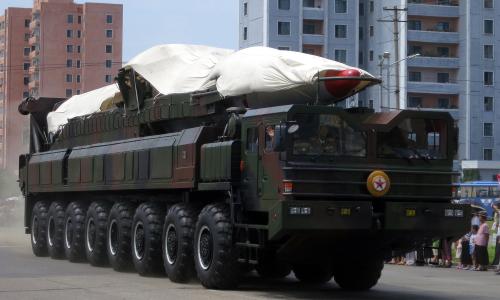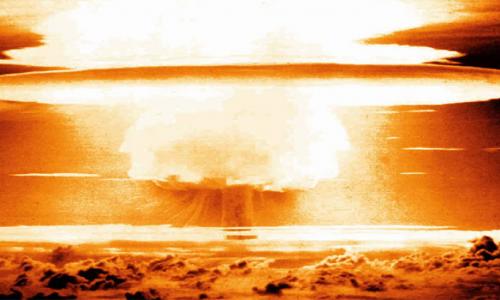The Bush administration is requesting $10 million in funding in fiscal year 2009 (FY09) for a Space Test Bed as part of its effort to develop a space-based missile defense system. The program would begin the process of putting weapons in space and would therefore have important long-term implications. Repeating the course taken in FY08, Congress should not fund this program.
What is it?
The Space Test Bed is a Missile Defense Agency (MDA) project in the Ballistic Missile Defense System Space Program (Program Element 0603895C). The intent of the program is to develop a space-based interceptor; to develop the command, control, battle management and communications structures for space-based missile defense; and to launch interceptors into orbit and test them against ballistic missiles.
MDA's FY09 budget request provides little detail about the program, which it describes as intended to "examine space capability as a potential complement to" the U.S. missile defense system. The request calls for developing the operational concepts for a space-based missile defense and preparing to "conduct focused experiments demonstrating the viability of the concepts," with component demonstrations to begin in FY11.
This language obscures the fact that the Test Bed would place prototype interceptors in space. Moreover, descriptions in previous years were more explicit about the goals of the program. The FY06 budget description states that "We plan to add a space-based defensive layer to complement" the U.S. missile defense system. The FY06 budget request stated that the Test Bed would initially consist of five space-based interceptors, and the production phase for a larger number of interceptors would begin in FY16.
Why does such a small R&D project matter?
Although the initial request for the Test Bed is small and is described as funding research and development, Congress should not support this program. As discussed below, space-based interceptors would not provide a credible defense against ballistic missiles, yet the technology being developed would be useful for offensive attacks on satellites. A Congressional decision to fund this program could send a message to other countries that the United States is developing a space-based anti-satellite (ASAT) capability. This apparent pursuit of space control technologies may encourage similar development by other countries, which would reduce U.S. security.
Moreover, by putting dedicated space-based weapons in orbit for the first time, the Test Bed—under the guise of research and development—would effectively preempt broader Congressional decision-making about space weapons. Congress has not a thorough debate of the wisdom of deploying space-based weapons, nor has it considered the desirability, feasibility, or costs of attempting to build a space-based anti-missile system or space-based ASAT weapons.
Space-based defenses: Enormously expensive, inherently ineffective
A space-based boost-phase missile defense system is intended to intercept attacking missiles during the first few minutes of their flight, while the missiles' engines are still burning. To reach attacking missiles during this very short time, space-based interceptors (SBIs) must be stationed in low-altitude orbits. However, in these orbits SBIs move rapidly with respect to the ground and cannot stay over any one location on Earth. To keep at least one interceptor within reach of a given missile launch site at all times therefore requires many SBIs in orbit. A 2003 American Physical Society study showed that many hundreds or thousands of SBIs would be required to provide limited global coverage against ballistic missiles. Moreover, given the technology expected for the next decade, each SBI would weigh a ton or more. As a result, deploying such a system would be enormously expensive.
Yet even if such a large system were built, it would not provide a reliable defense, since only one or two SBIs would be in position to reach a launching missile in time to destroy it. Consequently, the defense could be overwhelmed by simultaneously launching multiple missiles from one location. Moreover, the SBIs, being in predictable low-altitude orbits, would be vulnerable to attack by inexpensive, short-range missiles. By destroying a relatively few interceptors in this way, an attacker could create a hole in the defense through which it could launch its long-range missiles. In short, a defense based on deploying hundreds or thousands of space-based interceptors at enormous cost would be defeated by a handful of enemy missiles.
Anti-satellite capability
The SBIs, while not providing a useful defense against ballistic missiles, could have a significant ability to destroy satellites. Budget descriptions suggest that the boost-phase missile defense system may also be designed to intercept missiles during the midcourse, or unpowered, phase of flight. The sensors needed for midcourse intercepts would allow an interceptor to home on a satellite. Moreover, the large amount of thrust an interceptor needs to perform boost-phase missile defense from space would allow the interceptors to reach satellites in geostationary orbits as well as lower orbits.
The Test Bed's anti-satellite capability is certain to be recognized by other nations. This could encourage them to develop their own destructive ASAT weapons, which would threaten U.S. satellites and produce huge amounts of space debris that could hinder the use of space for decades.
Budget
Last year, the FY08 $10 million request was cut from the budget in both the Authorization and Appropriations Committees of both the House and Senate. This year, both the House and Senate Armed Services Committees have cut the FY09 funding for this program.
Funding for the Test Bed had been slated for several years to begin in FY08. The FY08 request was for less than previous requests, especially for future years. This reduction may indicate a decreased interest in the program, or recognition that other programs are a higher priority. Alternatively, it may indicate a decision to fund the effort primarily from the classified budget or to fund in other programs some elements that were previously included as part of the Test Bed.



